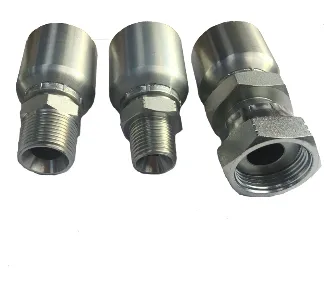335345435
Aug . 07, 2025 10:48 Back to list
Hydraulic Fittings: Types, Customization, and Where to Source Them
In any hydraulic system—whether in heavy equipment, manufacturing machinery, or mobile hydraulic units—fittings are just as important as hoses or pumps. They determine the connection quality, flow efficiency, pressure resistance, and overall safety of the entire circuit. Faulty or incompatible fittings can lead to fluid leaks, pressure drops, equipment failure, or worse—safety risks.
If you’re looking for hydraulic fittings for sale, evaluating different hyd fittings, or exploring options for custom hydraulic fittings, this guide covers everything you need to make the right purchase—and how to find reliable hydraulic fittings suppliers.

What Are Hydraulic Fittings?
Hydraulic fittings are mechanical components used to connect hoses, tubes, and pipes within a hydraulic system. They help route hydraulic fluid while maintaining a leak-free, high-pressure seal. These fittings must be strong, precision-machined, and compatible with the system's operating pressure, temperature, and fluid type.
They’re used in industries like:
Construction and agriculture
Oil & gas
Manufacturing and automation
Marine and aerospace
Material handling and logistics
Types of Hydraulic Fittings
There are hundreds of hyd fittings styles and configurations, but most fall under a few key categories:
1. Threaded Fittings
NPT (National Pipe Tapered): Tapered thread; common in North America. Requires thread sealant.
BSP (British Standard Pipe): Used internationally; available in BSPT (tapered) or BSPP (parallel).
JIC (Joint Industry Council): 37° flare fittings, reusable, widely used.
SAE (Society of Automotive Engineers): Straight thread with O-ring seal.
2. O-Ring Face Seal (ORFS)
Flat-faced fitting with an O-ring groove to provide leak-proof seal at high pressures (up to 6,000 PSI).
Ideal for systems where zero-leak is mandatory.
3. Compression Fittings
Often used with rigid tubes or stainless-steel lines.
Common in instrumentation and high-vibration environments.
4. Quick Disconnect (QD) Fittings
Fast connect/disconnect under pressure.
Used in mobile systems, testing equipment, or service lines.
5. Flange Fittings
Used in very high-pressure systems (over 6,000 PSI).
ISO 6162 and SAE J518 standards.
6. Push-to-Connect and Barbed Fittings
Found in low-pressure return lines or pneumatic systems.
Easy to install and cost-effective.
Each fitting has its pressure rating, torque spec, and compatibility standards that must match your hose or tube setup.
Custom Hydraulic Fittings
Not every system uses off-the-shelf connectors. Custom hydraulic fittings are often needed when:
Connecting between different thread standards (e.g., BSP to NPT)
Working in tight or limited-clearance environments
Designing new machinery with unique routing paths
Using proprietary equipment with non-standard ports
Custom fittings can include:
Elbow angles beyond 45°/90° (e.g., 60°, 135°)
Multi-port tees and crosses
Reducers, adapters, or manifolds
Stainless steel fittings for corrosive environments
Non-standard bore sizes or threads
OEMs and hose assembly shops often use CNC machining to create made-to-order fittings from brass, carbon steel, stainless steel, or aluminum.
Hydraulic Fittings Materials
|
Material |
Best For |
|
Carbon Steel |
Most common; high strength, cost-effective |
|
Stainless Steel |
Corrosive, sanitary, or marine environments |
|
Brass |
Low to medium pressure, better corrosion resistance |
|
Aluminum |
Lightweight systems or aviation applications |
Always confirm material compatibility with your hydraulic fluid (oil, water glycol, phosphate ester, etc.).
Hydraulic Fittings for Sale: Pricing Guide
Hydraulic fittings price varies depending on material, thread type, and pressure rating. Here's a rough 2025 estimate (USD per unit):
|
Fitting Type |
Material |
Price Range (USD) |
|
NPT/JIC adapters |
Carbon steel |
$1.50 – $5.00 |
|
ORFS male/female |
Carbon steel |
$3.00 – $10.00 |
|
Stainless 90° elbow |
Stainless steel |
$8.00 – $25.00 |
|
Quick couplers |
Brass or steel |
$10.00 – $45.00 |
|
Custom CNC fittings |
Steel/stainless |
$15.00 – $60.00+ |
Bulk orders (100+ pieces) or kits for equipment assembly often come at reduced unit costs.
Choosing the Right Hydraulic Fittings Supplier
A reputable hydraulic fittings supplier should provide:
Certified components (SAE, ISO, DIN, or JIS)
Material test reports (MTRs) for stainless steel or custom jobs
Fast fulfillment and high in-stock availability
Crimp specs and compatibility with your hose/ferrule brand
Technical support on selecting the correct sealing method
Look for suppliers who can scale—handling both emergency orders and scheduled production volumes.
Hydraulic Fittings FAQs
Q1: Can I mix different thread types in a hydraulic system?
A: Only with a proper adapter. Mixing NPT with BSP or SAE threads directly causes leaks or thread damage. Always use approved conversion fittings.
Q2: What’s the difference between ORFS and JIC fittings?
A: JIC uses a 37° flare for metal-to-metal sealing. ORFS uses a flat face with an O-ring, offering better leak protection under vibration and high pressure.
Q3: Are custom hydraulic fittings expensive?
A: Not necessarily. While CNC-machined parts may cost more than standard stock, in many cases they eliminate adapters, reduce assembly time, and save space.
Q4: Do hydraulic fittings come preassembled with hoses?
A: Yes—many hose shops offer full hose + fitting assemblies tailored to your specs, crimped, tested, and ready to install.
Q5: Where can I get hydraulic fittings in bulk or OEM packaging?
A: Contact large-scale suppliers or manufacturers who offer bulk purchasing, private labeling, and long-term supply contracts for OEMs and distributors.
-
LPG Hose: Choosing the Right Hose for Safe, Reliable Gas Transfer
NewsAug.07,2025
-
Industrial Hose: Types, Applications, and Where to Find Reliable Suppliers
NewsAug.07,2025
-
Hydraulic Hose Pipe: Types, Pricing, and How to Source the Right One
NewsAug.07,2025
-
Hydraulic Fittings: Types, Customization, and Where to Source Them
NewsAug.07,2025
-
High Pressure Washer Hoses: Buying Guide, Specs, and Supplier Insights
NewsAug.07,2025
-
Choosing the Right Gasoline Hose: Flexibility, Resistance, and Supply Options
NewsAug.07,2025



